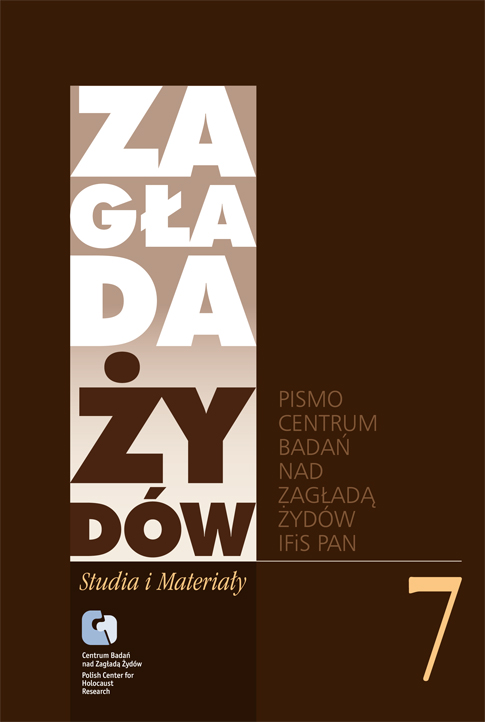Pre-history of Memory. Holocaust in Early American Entertainment Program
Zagłada Żydów. Studia i Materiały, No. 7 (2011), Pages: 303-317
Submission Date: 2020-12-13Publication Date: 2011-12-10
 https://doi.org/10.32927/zzsim.788
https://doi.org/10.32927/zzsim.788
Abstract
In the 1950s NBC regularly broadcast This Is Your Life! – a 30-minute talk show. The guests included well-known persons as well as unknown heroes of everyday life. A few times the invited guests were the so-called witnesses to history, including Holocaust survivor Czech Jewess Hanna Bloch Kohner. The episode of This Is Your Life! with Hanna Bloch Kohner is perhaps the first time that the Holocaust was used in a TV entertainment show after the war. The structural requirements of a new popular show genre forced the heroine to play a highly specific role, and the need to provide entertainment to the viewers significantly influenced the construction of her story. In that narration post-war American optimism clearly triumphed over the dramatic past of the European Jewish immigrant. This Is Your Life! broadcast Hanna’s story into a social context still insensitive to the historical dimension of the Holocaust. Hence, how does the not yet developed medium deal with such close and still unspecified history in the period of no fixed cultural references? To answer this question the author refers to the theory of collective memory and the notion of trauma on the one hand and to the theory of TV genres on the other.
Keywords
Holocaust representations , mass media , genre , talk show , memory , trauma
License
Copyright (c) 2011 Author & "Holocaust Studies and Materials"

This work is licensed under a Creative Commons Attribution 4.0 International License.
https://creativecommons.org/licenses/by/4.0
Similar Articles
- Aleksandra Ubertowska, New Geographies, New Subjects, and the New Media in Holocaust Studies. A Companion to the Holocaust , Zagłada Żydów. Studia i Materiały: No. 17 (2021)
- Jacek Leociak, Understanding the Holocaust. A Task for Generations , Zagłada Żydów. Studia i Materiały: 2008: Holocaust Studies and Materials
- Dan Michman, Dutch Society and the Jewish Fate: A Puzzling Record , Zagłada Żydów. Studia i Materiały: No. 12 (2016)
- Marta Duch-Dyngosz, In Search of Local Memory of the Holocaust. The Case of Commemoration of Jewish Communities in Smaller Towns in Contemporary Poland , Zagłada Żydów. Studia i Materiały: No. 17 (2021)
- Jacek Leociak, Marta Tomczok, Affective Holocaust Kitsch – Introduction , Zagłada Żydów. Studia i Materiały: No. 17 (2021)
- Katarzyna Chmielewska, Multidirectional and agonic memory vs. politics of memory , Zagłada Żydów. Studia i Materiały: No. 17 (2021)
- Jacek Leociak, “History and Memory after the Holocaust in Germany, Poland, Russia, and Britain” , Zagłada Żydów. Studia i Materiały: No. 3 (2007)
- Natalia Aleksiun, When Fajga Left Tadeusz. Wartime Relationships of Survivors after the Holocaust , Zagłada Żydów. Studia i Materiały: No. 17 (2021)
- Joanna Śliwa, A reviev: Agnieszka Witkowska-Krych, Dziecko wobec Zagłady. Instytucjonalna opieka nad sierotami w getcie warszawskim , Zagłada Żydów. Studia i Materiały: No. 19 (2023)
- Tomasz Łysak, Yolocaust: Platform Capitalism and Digital Holocaust Commemoration Practices , Zagłada Żydów. Studia i Materiały: No. 17 (2021)
1 2 3 4 5 6 7 8 9 10 11 12 13 14 15 16 17 18 19 20 21 22 23 24 25 26 27 28 29 30 31 32 33 34 35 36 37 38 39 40 41 42 43 44 45 46 47 48 49 50 > >>
You may also start an advanced similarity search for this article.
 English
English
 Język Polski
Język Polski








